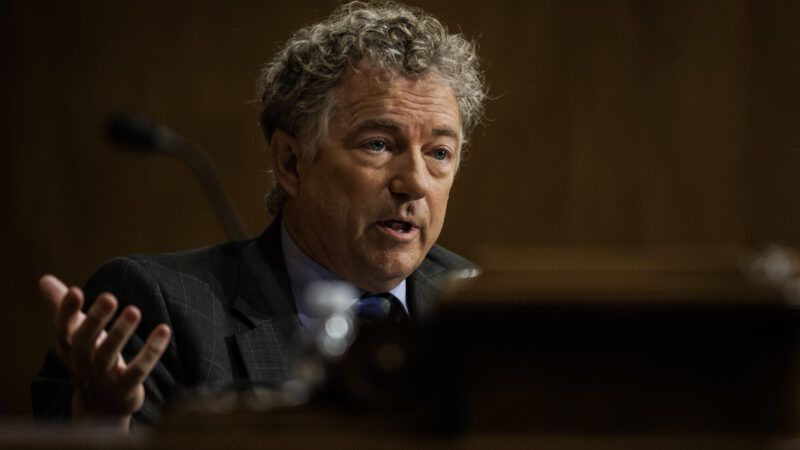Rand Paul Asked Senators To Balance the Budget. Only 28 Agreed.
Rising interest rates will only make it harder to balance the budget in future years.

As he pitched his Senate colleagues on a plan to balance the federal budget in 2018, Sen. Rand Paul (R–Ky.) warned that rising inflation would be one of the consequences of a failure to bring deficit spending under control.
At the time, Paul was pushing a bill that would have required a spending cut equal to one penny out of every dollar in the federal budget. The so-called "Penny Plan" would have balanced the federal budget by 2023, Paul claimed at the time, without requiring serious cuts to any specific programs. Paul exerted senatorial privilege to force a vote on the package; it failed 21–76.
That was before the federal government borrowed trillions of dollars in the name of combatting the COVID-19 pandemic. It was before President Joe Biden's $1 trillion infrastructure package. It was before four more years of bulging federal budgets authorized by a Congress that's increasingly blithe about borrowing.
With inflation now running seemingly out of control and trillion-dollar deficits being the new norm in Washington, Paul was back on the Senate floor Wednesday to offer another bill to balance the budget in five years. This time around, however, it would require cutting six cents for every budgetary dollar.
The proposal failed, 29–67.
"Washington's addiction to spending is hurting our economy and depleting our currency. Inflation is stealing every American's purchasing power and financial security," Paul said in a statement after the vote. "All this plan does is return to 2019 spending levels. If the federal government spent at 2019 levels this year, we would have a $388 billion surplus."
Indeed, about the only thing that's changed in the four years since Paul offered the Penny Plan is the size of the numbers involved. America has piled up an incredible $11 trillion of debt since 2018—that's more than one-third of the nation's total credit card bill—as annual budget deficits surged even before emergency pandemic borrowing blew them through the roof.
President Donald Trump oversaw an expansion of debt-fueled government spending during his term in office, and Biden has followed suit. In his first year in office, Biden has added $2.4 trillion to the nation's long-term deficit—despite the White House's best efforts to hide that fact.
In the face of this unsustainable fiscal situation, an across-the-board cut of six pennies per every dollar to balance the budget seems like a pretty good deal. But the jump from the Penny Plan to the Six-Penny Plan over a period of just four years serves as a nice illustration of how Congress has completely lost control of the fiscal situation.
And things are rapidly spiraling. The Federal Reserve announced a 0.75 percent interest rate hike on Wednesday, just hours before Paul presented his budget plan on the Senate floor. Those higher interest rates will rebound into the federal budget in the form of higher interest payments on the national debt. Under the Congressional Budget Office's (CBO) latest budgetary baseline, interest payments on the debt are expected to triple between now and 2032. If interest rates climb higher than the CBO expects, however, the federal government could be paying trillions more simply to finance government spending that already occurred.
Obviously, that will make any future attempt at balancing the budget an even more difficult task.
The opportunity to balance the budget by cutting a mere penny out of every dollar of federal spending has come and gone. After Wednesday's vote, the Six Penny Plan's days are likely numbered too.
Show Comments (95)